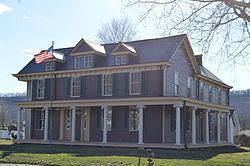Built c. 1850 NRHP Reference # 02001521 Added to NRHP 12 December 2002 | Architectural style I-House Area 2,400 m² | |
 | ||
Location 1111 Wheeling Ave., Glen Dale, West Virginia | ||
Bennett Cockayne House is a historic home located at Glen Dale, Marshall County, West Virginia. It was built about 1850, in a vernacular I-house style. It is a two-story, wood-frame building with wooden clapboard siding and a slate roof. Also on the property are a contributing supply shed (c. 1900) and water pump (c. 1900).
It was listed on the National Register of Historic Places in 2002.
Built by Moundsville postmaster Bennett Cockayne circa 1850, the Cockayne house served as the first school house in what would later be known as the town of Glen Dale, WV. During the era of Bennett’s son, Samuel A.J. Cockayne, whose footprints and initials are imprinted in the stone hearth of the farmhouse, the farm on which the home stood went on to enjoy worldwide Agricultural acclaim. Samuel A.J. purchased sheep, cattle, hogs and other livestock from distant farms in order to produce the finest product.
In 1877 the farm was published in what some historians now consider to be “the most extraordinary “county atlas” produced in the Nineteenth-Century” when a lithograph of the farm was included in the Illustrated Atlas of the Upper Ohio River Valley from Pittsburgh to Cincinnati. Samuel A.J. and his wife Hannah Jane Alexander, whom he married in 1863, continued to work the farm for the rest of their lives and by the time their son Samuel A. inherited the farmhouse and most of the farm in 1917, it had already been renamed “Glendale Farm.”
Samuel A. carried the Cockayne legacy well. Not only did he carry on the farming tradition of the family and earn the designation of “county wool dealer” in 1917, he gathered wool from local farmers and combined with his own wool, distributed products to eastern markets. In 1924 Samuel A. oversaw the naming of the town of Glen Dale in honor the farm and went on to become a member of the Washington District Board of Education in the 1930s and was also Postmaster of the city of Glen Dale from 1935 to 1950.
Samuel A’s later years saw many of the responsibilities for running the farm passed down to his son Samuel A.J. Although Samuel A.J. had every intention of dedicating his life to the running of the farm, even going as far as to drop out of high school during his junior year, his induction into the military during World War II delayed those ambitions.
Upon his return from the military Samuel A.J, having endured many traumatic experiences while fighting in the Pacific Theater during the war, as well as the passing of his mother in 1945 and his father in 1954, began adopting a reclusive lifestyle. Although he continued to farm the land of his ancestors until he sold part of it in order to make way for John Marshall High School in 1965, he chose to spend the majority of his life in only two rooms of the large mansion built by his earlier decedents.
It was the secluded nature of war hardened Samuel A.J. that left the rest of the home to be practically frozen in the Nineteenth-Century. The interior of the house features over 1,500 family relics such as photographs and oil paintings of early descendants, a square grand piano complete with original bill of sale issued in 1881, books dating from the 1700s, handwritten letters from the 1800s and handmade furniture from over 200 years ago.
As a gift to the City of Glen Dale, as well as to future generations of individuals interested in learning about the past, Samuel A.J. donated the house and its contents upon his passing in 2001. The city immediately began a partnership with the Marshall County Historical Society aiding and expediting the efforts of the community to document, preserve and restore the Cockayne properties. The first major accomplishment of the Cockayne Historical Preservation Committee which works within the Marshall County Historical Society was the induction of the Cockayne Property into the National Register of Historic Places in 2002.
Although much has already been accomplished in order to prepare the Cockayne House as a vehicle to educate future students about the past, there is much work left to be done. One thing that can be conclusively stated however is that the house that Bennett Cockayne built almost 160 years ago and that saw so many generations pass through its doors, as well as the property surrounding it, is in good hands.
